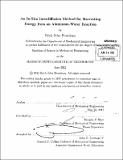| dc.contributor.advisor | Douglas P. Hart. | en_US |
| dc.contributor.author | Brandeau, Erich John | en_US |
| dc.contributor.other | Massachusetts Institute of Technology. Dept. of Mechanical Engineering. | en_US |
| dc.date.accessioned | 2012-10-26T18:07:56Z | |
| dc.date.available | 2012-10-26T18:07:56Z | |
| dc.date.copyright | 2012 | en_US |
| dc.date.issued | 2012 | en_US |
| dc.identifier.uri | http://hdl.handle.net/1721.1/74424 | |
| dc.description | Thesis (S.B.)--Massachusetts Institute of Technology, Dept. of Mechanical Engineering, 2012. | en_US |
| dc.description | Cataloged from PDF version of thesis. | en_US |
| dc.description | Includes bibliographical references (p. 57-58). | en_US |
| dc.description.abstract | Autonomous underwater vehicles (AUVs) are indispensable for countless underwater tasks but are currently limited in their range and endurance by the energy density of their battery packs. Aluminum is an ideal energy source for AUVs because it exothermically reacts with water and is two orders of magnitude more energy dense than current lithium-ion batteries. An in-situ interdiffusion method for reacting aluminum in water was conceived in which elemental aluminum is able to overcome the passivating aluminum oxide layer by diffusing into liquid gallium. The aluminum atoms in solution with the gallium react to produce heat and hydrogen gas when they reach the interface of the liquid gallium and water. This thesis attempts to quantify the diffusion of aluminum into liquid gallium as well as to quantify the reaction of the aluminum-gallium solution in water. Experiments are conducted to measure the diffusion and reaction rate constants, and the data is fit to the Arrhenius equation to predict the diffusion and reaction rates at elevated system temperatures. With the predicted diffusion and reaction rates, it was found how the size and temperature effect the power output of an in-situ inderdiffusion aluminum-water reactor. | en_US |
| dc.description.statementofresponsibility | by Erich John Brandeau. | en_US |
| dc.format.extent | 58 p. | en_US |
| dc.language.iso | eng | en_US |
| dc.publisher | Massachusetts Institute of Technology | en_US |
| dc.rights | M.I.T. theses are protected by
copyright. They may be viewed from this source for any purpose, but
reproduction or distribution in any format is prohibited without written
permission. See provided URL for inquiries about permission. | en_US |
| dc.rights.uri | http://dspace.mit.edu/handle/1721.1/7582 | en_US |
| dc.subject | Mechanical Engineering. | en_US |
| dc.title | An in-situ interdiffusion method for harvesting energy from an aluminum-water reaction | en_US |
| dc.type | Thesis | en_US |
| dc.description.degree | S.B. | en_US |
| dc.contributor.department | Massachusetts Institute of Technology. Department of Mechanical Engineering | |
| dc.identifier.oclc | 813044821 | en_US |
